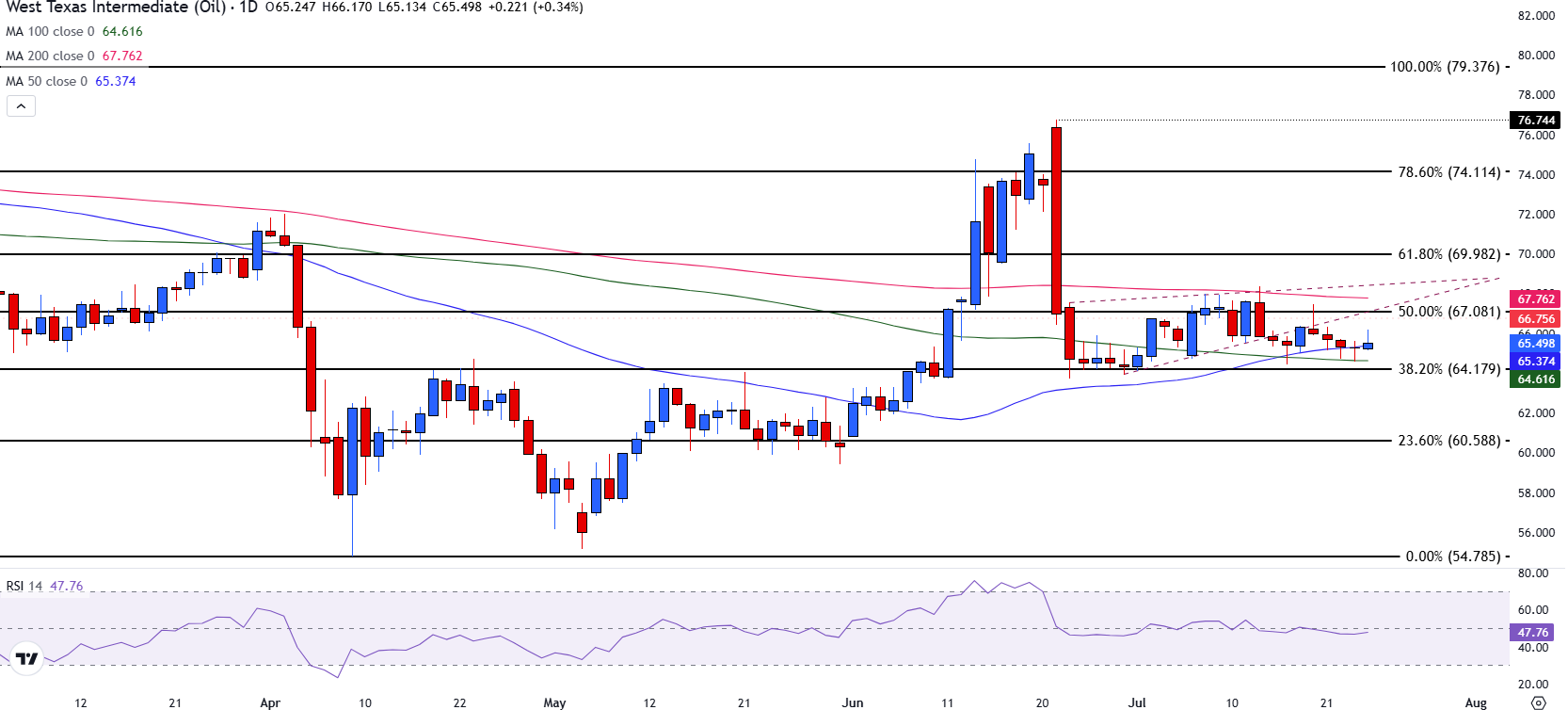WTI Crude rallies despite Chevron’s return to Venezuela shifting supply outlook
- WTI Crude Oil rallies with technicals hinting at a potential breakout as consolidation builds.
- Oil whipsaws as easing trade tensions raise the demand outlook.
- US President Donald Trump reinstates Chevron's license to operate in Venezuela.
West Texas Intermediate (WTI) is attempting a breakout as traders weigh conflicting signals from supply and demand.
At the time of writing, WTI is trading near $66.00, with the gains nearing 1%.
Easing trade tensions and improving demand expectations have been offset by increasing OPEC+ output and news that the Trump administration has reinstated Chevron’s license to produce oil in Venezuela.
A Wall Street Journal article published Thursday reported that the Trump administration has reinstated Chevron’s license to pump oil in Venezuela.
This reverses a revocation from earlier this year. The move follows a prisoner exchange in which Venezuela released 10 detained Americans last Friday.
Chevron’s reauthorization marks a significant policy shift and potentially opens the door for increased Oil exports from the South American nation despite years of heavy US sanctions.
The Biden administration had previously allowed Chevron to engage in limited operations in Venezuela under strict conditions. That license was rescinded earlier in the year under President Trump’s return to office.
The new authorization paves the way for Chevron to resume pumping crude in the country, which holds the world’s largest proven Oil reserves.
While underlying global demand faces headwinds from trade tensions, the critical new factor on the supply side is the US policy shift.
This development, viewed as a potential move to increase supply and manage geopolitical influence, is likely contributing to the current indecision in the WTI market and could cap upside potential as traders factor in the prospect of more crude flowing from Venezuela.
WTI Crude Oil holds a tight range as technicals hint at a potential breakout
From a technical perspective, WTI Crude remains confined within a narrowing range despite efforts from bulls to push through the $66.00 range. The recent move has allowed the price to recover above the 50-day Simple Moving Average (SMA) support level at 65.38, and the 100-day SMA is providing support at 64.62.
On the upside, a move above the $66.00 psychological level a break of the 50% Fibonacci level of the January-April decline near $67.00 could open the door for the 200-day SMA at 67.76.
In contrast, if bears gain traction below the 100-day SMA and break the 38.2% Fibo level of $64.18, this could drive prices back toward the $62.00 mark, last tested in June.

The Relative Strength Index (RSI) is holding near 50, reflecting a neutral momentum backdrop and reinforcing the current market indecision. For now, WTI is in a holding pattern, with traders watching closely for a decisive move that could define the next directional trend.
WTI Oil FAQs
WTI Oil is a type of Crude Oil sold on international markets. The WTI stands for West Texas Intermediate, one of three major types including Brent and Dubai Crude. WTI is also referred to as “light” and “sweet” because of its relatively low gravity and sulfur content respectively. It is considered a high quality Oil that is easily refined. It is sourced in the United States and distributed via the Cushing hub, which is considered “The Pipeline Crossroads of the World”. It is a benchmark for the Oil market and WTI price is frequently quoted in the media.
Like all assets, supply and demand are the key drivers of WTI Oil price. As such, global growth can be a driver of increased demand and vice versa for weak global growth. Political instability, wars, and sanctions can disrupt supply and impact prices. The decisions of OPEC, a group of major Oil-producing countries, is another key driver of price. The value of the US Dollar influences the price of WTI Crude Oil, since Oil is predominantly traded in US Dollars, thus a weaker US Dollar can make Oil more affordable and vice versa.
The weekly Oil inventory reports published by the American Petroleum Institute (API) and the Energy Information Agency (EIA) impact the price of WTI Oil. Changes in inventories reflect fluctuating supply and demand. If the data shows a drop in inventories it can indicate increased demand, pushing up Oil price. Higher inventories can reflect increased supply, pushing down prices. API’s report is published every Tuesday and EIA’s the day after. Their results are usually similar, falling within 1% of each other 75% of the time. The EIA data is considered more reliable, since it is a government agency.
OPEC (Organization of the Petroleum Exporting Countries) is a group of 12 Oil-producing nations who collectively decide production quotas for member countries at twice-yearly meetings. Their decisions often impact WTI Oil prices. When OPEC decides to lower quotas, it can tighten supply, pushing up Oil prices. When OPEC increases production, it has the opposite effect. OPEC+ refers to an expanded group that includes ten extra non-OPEC members, the most notable of which is Russia.


